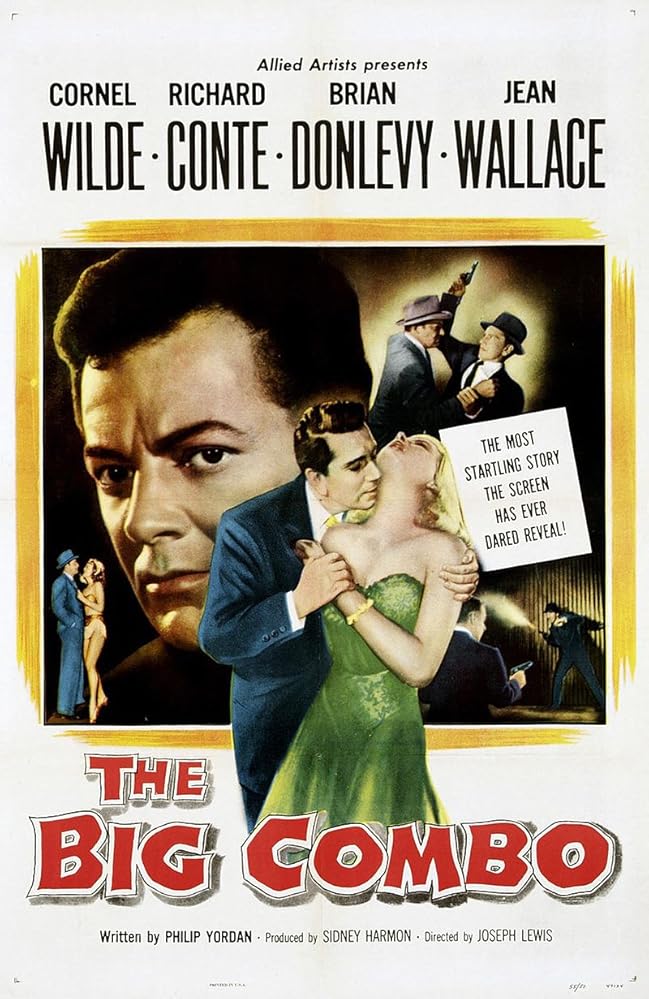
BIG COMBO, THE
(director: Joseph H. Lewis; screenwriter: Philip Yordan; cinematographer: John Alton; editor: Robert S. Eisen; cast: Cornel Wilde (Police Lt. Leonard Diamond), Capt. Peterson (Robert Middleton), Richard Conte (Mr. Brown), Lee Van Cleef (Fante), Brian Donlevy (Joe McClure), Jean Wallace (Susan Lowell), Earl Holliman (Mingo), Helen Walker (Alicia), Jay Adler (Sam Hill), John Hoyt (Dreyer), Ted de Corsia (Bettini), Helene Stanton (Rita); Runtime: 89; Allied Artists; 1955)
“Conte is convincing as the maniacal hood, while Wilde is a good counter-balance to Conte. “
Reviewed by Dennis Schwartz
An action-packed sleazy crime drama that pits a sadistic crime lord, Mr. Brown (Conte), against a police lieutenant, Leonard Diamond (Wilde), who is obsessed to smash Brown’s crime syndicate. This film noir features a perverse sexual relationship between gangster Brown and a thrill-seeking society girl, Susan Lowell (Wallace), who stays with him for four years even though he treats her as a possession and she knows he’s a ruthless killer. She can’t leave him, as he knows what buttons to push to make her body quake for him. There is a sense of doom that all the main characters share, as they also share a sense of mixing violence with sex. There are no healthy characters shown; even the good-guy cop is fighting his dark side. John Alton’s photography, in a stark black and white tint, helps explore this ominous dark world of violent men, dangerous alleys and stylish penthouses.
Unable to get out of the deadly relationship with Mob financier Brown, as Brown has Susan followed everywhere by hitmen Fante (Van Cleef) and Mingo (Holliman), she tries to commit suicide by taking too many pills. When unconscious in the hospital, Susan called out the name Alicia. This is the lead that Diamond has been waiting for to nail Brown, as he tries to convince his superior, Captain Peterson (Middleton), to keep him on the case. The captain is finding it difficult to justify the expenses of investigating suspected Mob boss Mr. Brown for such a long time without any results. As a desperate measure Diamond arrests Brown and over ninety of his gang members, as he only asks them who Alicia is. Diamond is rewarded for his effort by getting the name Bettini (de Corsia) from Brown’s lie detector test. Bettini is relieved it’s only the cops and not the Mob, as she tells Diamond that Alicia was Brown’s wife.
Diamond gets the ire of Brown after all those arrests, and Fante and Mingo bring the meddlesome cop to their hideout and in a dark room they torture him–using the hearing aid of second banana hood McClure (Donlevy) to bring up the volume beyond tolerant levels.
When the gangsters are finished with the cop, they pour hair tonic down his throat so that Diamond appears drunk and they dump him on the doorstep of Captain Peterson. This torture session only makes Diamond more obsessed with getting Brown. Diamond follows up the lead Bettini gives him and sees the former skipper, a Swede called Dreyer (Hoyt), of the boat that Alicia, Grazzi, and Brown chartered when they were last seen. Dreyer now owns an antique shop thanks to Brown.
Thinking Alicia was killed, Diamond soon learns through the help of Susan that Alicia is alive. By deciphering the clues in the recent photo of Alicia that Susan gives him as she steals it from Brown’s vault, Diamond figures out she’s in a private sanitarium. Diamond also figures out that it was Grazzi who was killed on that boat and not Alicia, and he now goes after Brown with a renewed vigor.
But McClure also knows that Grazzi is dead and that Diamond knows this. McClure is jealous that Brown heads the syndicate instead of him and sees his big chance to head the syndicate by getting the hitmen to go along with him and double-cross the boss. Instead, McClure’s killed by them. As an odd touch to his execution, Brown out of mock compassion removes his hearing aid so he won’t hear the bullets.
Warning: spoiler to follow in next paragraph.
At last, Diamond gets Alicia to spill the beans about Brown killing his crime boss and dumping his body overboard, and of his placing her in the insane asylum to shut her up. When Brown tries to escape, Diamond traps him inside an airplane hangar as Susan shines the high beam lights on him.
Lewis has created a nasty film noir, where all the characters are sullied by their peculiar sexual habits. The sadistic hitmen Fante and Mingo, give all indications that they are in a fatalistic homosexual relationship that is heightened by their need for violence as a stimulant. The hero, Diamond, seems to be so compulsively motivated by his strong actions against Brown, because he’s repressed and is secretly envious of Brown for attracting such a desirable woman. While Brown is a classical Freudian example of a nobody who dominates others by keeping them down. He’s a former prison guard, who hides behind his insecurities by using his blinding hatred and insatiable sex drive and controlling nature to keep others in their place. His thing is to make everyone call him Mr. Brown and look up to him. He insults the cop by saying he gets the same wages as a busboy in one of the hotels he owns.
Conte is convincing as the maniacal hood, while Wilde is a good counter-balance to Conte. He stylishly plays his persistent cop-seeking-revenge role with a sense of reckless grit, as each becomes the alter ego of the other. The film had a rawness that made it a compelling watch.
REVIEWED ON 8/19/2001 GRADE: B